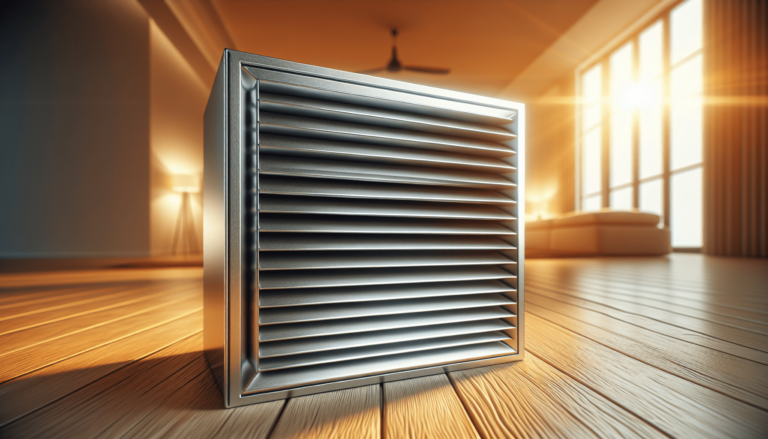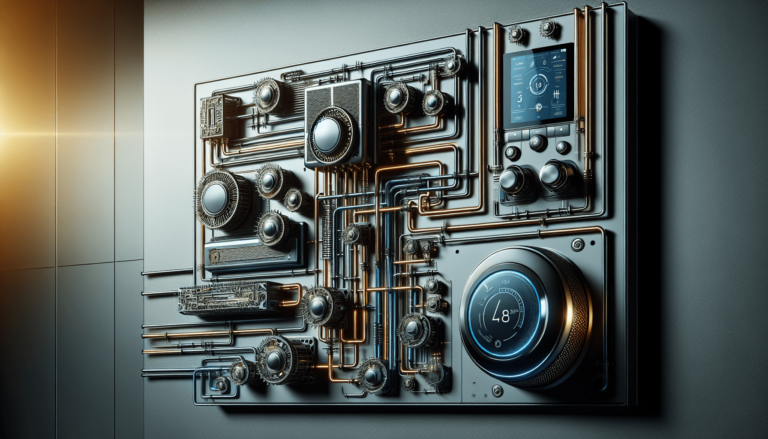

HVAC Services
Get Professional Repairs From The Area's Trusted HVAC Technicians. Ask About Our Services! We Offer Professional Heating & Cooling System Repairs And Guarantee Long-Lasting Results.
Got Question? Call us: (850) 678-2665Financing
Thermostat Settings: The Heart Of HVAC Efficiency
Maximize HVAC efficiency with the right thermostat settings. Reduce energy consumption, lower utility bills, and create a comfortable indoor environment. Learn more now!

Are you looking to maximize the efficiency of your HVAC system? Look no further than your thermostat settings. Believe it or not, the thermostat is the heart of HVAC efficiency. With the right settings, you can significantly reduce energy consumption, lower utility bills, and create a comfortable indoor environment. The team at Tempacure Heating and Air Conditioning understands the importance of thermostat settings in optimizing HVAC performance. Located in Niceville, FL, they offer expert advice and services to help homeowners make the most out of their heating and cooling systems. Whether you’re looking to save money or enhance comfort, getting your thermostat settings right is the key. So, let’s take a closer look at this pivotal aspect of HVAC efficiency and discover how you can benefit from it.
Importance of Thermostat Settings
When it comes to managing your home’s heating and cooling, thermostat settings play a crucial role. Not only do they determine the temperature inside your home, but they also have a significant impact on energy usage, comfort levels, and the overall lifespan of your HVAC system. By understanding and optimizing your thermostat settings, you can create a more energy-efficient and comfortable living environment while preventing excessive wear and tear on your system.
Optimizing energy usage
One of the main benefits of properly setting your thermostat is optimizing energy usage. By finding the right balance between comfort and efficiency, you can significantly reduce your energy bills without sacrificing comfort. Setting your thermostat to higher temperatures in the summer and lower temperatures in the winter can help minimize the workload on your HVAC system, resulting in lower energy consumption.
Maintaining comfort levels
Another crucial aspect of thermostat settings is maintaining optimal comfort levels throughout your home. Everyone has different preferences when it comes to indoor temperatures, and setting your thermostat according to your comfort needs is essential. Whether you prefer a slightly cooler bedroom for a good night’s sleep or a warmer living room for cozy evenings, adjusting the temperature settings accordingly can help ensure your comfort all year round.
Preventing excessive wear and tear
Your HVAC system works hard to keep you comfortable, but excessive usage can lead to wear and tear over time. By using your thermostat wisely, you can prevent unnecessary strain on your system, prolonging its lifespan and reducing the need for repairs or replacements. Setting your thermostat to efficient temperatures and avoiding extreme temperature changes can go a long way in preserving the health and longevity of your HVAC system.
Understanding Thermostat Terminology
To make the most of your thermostat settings, it’s important to familiarize yourself with some common terminology associated with thermostat controls, including temperature settings, fan settings, and the difference between programmable and non-programmable thermostats.
Temperature settings
Temperature settings refer to the desired indoor temperature you want to maintain. Most thermostats allow you to set your desired temperature with degrees in Fahrenheit or Celsius. By setting the temperature to your preferred comfort level, the thermostat will regulate the heating or cooling to achieve and maintain that temperature.
Fan settings
The fan settings on your thermostat determine how the fan operates in your HVAC system. There are typically two options: “on” and “auto.” When set to “on,” the fan will run continuously, even when the heating or cooling system is not actively running. This can help with air circulation but may result in slightly higher energy consumption. On the other hand, when set to “auto,” the fan will only run when the heating or cooling system is actively running, resulting in lower energy usage.
Programmable vs. non-programmable thermostats
The type of thermostat you have in your home can significantly impact your energy efficiency and convenience. Programmable thermostats allow you to set different temperature schedules throughout the day, allowing you to save energy when you’re away or asleep. Non-programmable thermostats, on the other hand, require manual adjustment and don’t offer the same level of automation. Choosing the right thermostat type for your needs is important to optimize energy usage and comfort.
Recommended Temperature Settings
Finding the ideal temperature settings for different seasons can help you strike the perfect balance between comfort and energy savings. While personal preferences may vary, there are some general guidelines you can follow to optimize energy usage and ensure comfort in your home.
Ideal temperatures for different seasons
During the summer months, it is recommended to set your thermostat to around 78 degrees Fahrenheit when you’re at home. This temperature provides a comfortable living environment without unnecessarily straining your HVAC system. When you’re away or asleep, consider setting the temperature a few degrees higher to save energy.
In the winter, a temperature setting of around 68 degrees Fahrenheit is typically comfortable for most people. Lowering the temperature by a few degrees when you’re not at home or during nighttime can help conserve energy without sacrificing comfort.
Considerations for energy savings
While it’s important to prioritize your comfort, there are additional considerations for energy savings. For every degree you raise the temperature during summer or lower it during winter, you can save about 1% on your energy bill. By adjusting your thermostat settings strategically, such as using setback temperatures when you’re away or asleep, you can achieve significant energy savings over time.
Exploring setback temperatures
Setback temperatures refer to temporarily adjusting your thermostat settings to conserve energy when you’re not at home or during certain hours of the day. Many programmable thermostats offer this feature, allowing you to pre-program temperature setbacks for specific time periods. By raising the temperature in the summer or lowering it in the winter while you’re away, you can save energy without sacrificing comfort. Just ensure that you set the setback temperature to a level where your HVAC system can efficiently bring the temperature back to your desired comfort level once you return.
Optimizing Fan Settings
The fan settings on your thermostat can have a significant impact on both energy consumption and air circulation within your home. Understanding the difference between “on” and “auto” mode and their effects can help you make informed decisions when setting your thermostat.
On vs. auto mode
The “on” mode on your thermostat means that the fan runs continuously, regardless of whether the heating or cooling system is actively running. This provides consistent air circulation throughout your home but can result in slightly higher energy consumption. The “auto” mode, on the other hand, means that the fan only runs when the heating or cooling system is actively running. This mode is generally more energy-efficient but may result in slightly less consistent air circulation.
Effect on energy consumption
Choosing the appropriate fan mode can significantly impact your energy consumption. If you prioritize air circulation and prefer a constant flow of air throughout your home, setting the fan to “on” may be suitable for you. However, if energy efficiency is a top priority, opting for the “auto” mode can help reduce unnecessary energy usage. It’s important to strike a balance between comfort and energy savings when deciding on the fan setting.
Air circulation benefits
Proper air circulation is essential for maintaining a healthy and comfortable indoor environment. The fan setting on your thermostat can play a role in promoting air circulation throughout your home. When the fan runs continuously in the “on” mode, it helps distribute conditioned air more evenly, preventing hot or cold spots. Additionally, the constant airflow can also help filter out airborne particles, improving your indoor air quality. If air circulation and indoor air quality are your concerns, the “on” mode may be a favorable option for you.
Choosing the Right Thermostat
Selecting the right thermostat for your home is crucial in maximizing comfort, energy efficiency, and convenience. Understanding key factors to consider, different types of thermostats available, and the benefits of smart thermostats can help you make an informed decision.
Factors to consider
When choosing a thermostat, consider factors such as your lifestyle, budget, and desired level of automation. If you have a consistent schedule and prefer a hands-on approach, a non-programmable thermostat may suffice. However, if you have a variable schedule or want to optimize energy savings, a programmable or smart thermostat can offer greater flexibility and convenience. Additionally, consider compatibility with your existing HVAC system and ensure that the thermostat you choose is able to control both heating and cooling.
Types of thermostats
There are several types of thermostats available on the market, each with its own features and capabilities. Non-programmable thermostats offer basic temperature control without the ability to schedule temperature changes. Programmable thermostats provide the ability to create customized temperature schedules to save energy based on your daily routine. Smart thermostats take programmability to the next level, allowing for remote access, learning capabilities, and integration with smart home systems.
Smart thermostats and their benefits
Smart thermostats, with their advanced features and connectivity, offer numerous benefits for homeowners. They provide remote access through smartphone apps, allowing you to control your thermostat settings from anywhere, anytime. Some smart thermostats even have learning algorithms that adjust temperature settings based on your habits and preferences, optimizing energy usage without the need for manual programming. Integration with smart home systems enables enhanced automation and voice control, offering a seamless and convenient experience.
Programming Your Thermostat
Once you have chosen the right thermostat for your home, it’s time to program it according to your preferences and schedule. By understanding the scheduling options, creating a personalized schedule, and taking advantage of pre-programming, you can maximize energy savings and ensure optimal comfort.
Understanding scheduling options
Programmable thermostats offer various scheduling options to accommodate your lifestyle. Common scheduling options include weekday/weekend schedules, 5-2 day schedules, and 7-day schedules. Weekday/weekend schedules allow for different temperature settings Monday through Friday and on weekends. 5-2 day schedules offer unique temperature settings for weekdays and weekends. 7-day schedules provide the flexibility to set different temperature settings for each day of the week. Understanding these options can help you tailor your thermostat programming to your specific needs.
Creating a personalized schedule
Creating a personalized schedule on your programmable thermostat involves considering your daily routine and temperature preferences throughout the day. Start by determining when you typically leave the house and arrive home, as well as when you go to bed and wake up. Set temperatures accordingly to conserve energy when you’re away or asleep and to ensure comfort when you’re at home and awake. Experiment with different temperature settings and monitor your comfort and energy usage to fine-tune your schedule over time.
Benefits of pre-programming
One of the biggest benefits of programmable thermostats is the ability to pre-program temperature settings in advance. This means you can set up your desired schedule for the upcoming week or month, and the thermostat will automatically adjust the temperature according to your programmed settings. Pre-programming eliminates the need for manual adjustments each day, saving you time and ensuring consistent energy efficiency. Just be sure to review and update your schedule periodically to account for any changes in your routine or seasons.
Utilizing Thermostat Features
Beyond basic temperature control, thermostats often come with additional features that can enhance your overall HVAC system performance. Understanding and utilizing these features, such as zoning capabilities, humidity control, and air filter maintenance reminders, can further optimize your energy usage and indoor comfort levels.
Zoning capabilities
Zoning capabilities allow you to divide your home into different zones and control the temperature independently in each zone. This is achieved by installing dampers in your ductwork that can direct conditioned air to specific zones as needed. Zoning can be especially beneficial if different areas of your home have varying temperature needs or if you have unused rooms that don’t require consistent heating or cooling. By only conditioning the zones that are actively being used, you can save energy and enhance comfort.
Humidity control
Some thermostats offer built-in humidity control features, allowing you to maintain optimal humidity levels within your home. High humidity can make your home feel uncomfortable and contribute to the growth of mold and mildew. Conversely, low humidity can cause dryness, static electricity, and respiratory discomfort. By setting your thermostat to control and maintain the desired humidity level, you can create a more comfortable and healthier indoor environment.
Air filter maintenance reminders
HVAC systems rely on clean air filters to operate efficiently and maintain good indoor air quality. Many thermostats now come with air filter maintenance reminders that notify you when it’s time to clean or replace your air filter. Regular air filter maintenance helps prevent dust and debris buildup, ensures proper airflow, and prolongs the lifespan of your HVAC system. By heeding these reminders and regularly maintaining your air filters, you can optimize your system’s performance and prevent potential issues.
Common Thermostat Mistakes to Avoid
While using your thermostat properly can help maximize energy efficiency and comfort, there are some common mistakes to avoid. Being mindful of frequent and drastic temperature changes, ensuring correct thermostat placement, and not ignoring thermostat maintenance can go a long way in optimizing your thermostat usage.
Frequent and drastic temperature changes
Making frequent and drastic temperature changes can put unnecessary strain on your HVAC system and result in higher energy consumption. Instead of abruptly adjusting the temperature to extreme levels, opt for gradual temperature changes and monitor your comfort level accordingly. This allows your HVAC system to function more efficiently and prevents sudden temperature fluctuations, creating a more stable and comfortable indoor environment.
Incorrect thermostat placement
Thermostat placement is crucial for accurate temperature readings and optimal performance. Avoid installing your thermostat in areas that are prone to extreme temperatures, such as near direct sunlight, drafty windows, or heat-generating appliances. Additionally, ensure that your thermostat is centrally located in your home and away from any obstacles that may impede proper airflow. By placing your thermostat in an optimal location, you can ensure accurate temperature control and prevent unnecessary heating or cooling.
Ignoring thermostat maintenance
Like any other device, thermostats require regular maintenance to ensure optimal performance. Ignoring thermostat maintenance, such as cleaning, battery replacement, and firmware updates, can lead to inaccurate temperature readings and potential malfunctions. Clean your thermostat periodically to remove any dust or debris that may obstruct sensors. Replace the batteries as recommended by the manufacturer to avoid power failures. Additionally, keep your thermostat firmware updated to access any bug fixes or new features released by the manufacturer.
Tips for Troubleshooting Thermostat Issues
Even with proper usage and maintenance, you may encounter occasional thermostat issues. Understanding common problems and their solutions, knowing when to seek professional assistance, and keeping your thermostat firmware updated can help you troubleshoot and resolve these issues effectively.
Common problems and solutions
Some common thermostat problems include unresponsive controls, inaccurate temperature readings, and incorrect system operation. If you experience unresponsive controls, check the batteries, clean the contacts, and ensure proper wall mounting. For inaccurate temperature readings, recalibrate the thermostat or adjust the placement for better accuracy. If your system is not operating correctly, check the wiring connections, filters, and fuses. Refer to your thermostat’s user manual or contact the manufacturer for specific troubleshooting steps.
When to seek professional assistance
If you’re unable to troubleshoot or resolve thermostat issues on your own, it may be necessary to seek professional assistance. HVAC professionals have the knowledge and experience to diagnose and repair more complex thermostat problems. They can also ensure that your HVAC system is functioning optimally and that the thermostat is properly calibrated and programmed for efficiency and comfort. If you’re unsure about the cause or solution to your thermostat issues, it’s best to contact a professional for assistance.
Keeping thermostat firmware updated
Thermostats, particularly smart thermostats, often receive firmware updates from the manufacturer. These updates may include bug fixes, security enhancements, or new features. Keeping your thermostat firmware updated ensures that you have the latest software and improvements, maximizing the functionality and performance of your thermostat. Many smart thermostats offer automatic firmware updates, but it’s good practice to periodically check for updates manually to ensure you’re benefiting from the latest enhancements.
Future Innovations in Thermostat Technology
Thermostat technology continues to evolve, offering exciting possibilities for the future. From integration with smart home systems to artificial intelligence advancements and wireless and remote access features, the future of thermostat technology holds great potential.
Integration with smart home systems
As smart home systems become increasingly prevalent, thermostats are expected to integrate seamlessly with other smart devices. This allows for enhanced automation and convenience, such as voice control, geofencing to adjust temperature settings based on your location, and integration with other smart devices to optimize energy usage. Imagine a future where your thermostat communicates with your lights, blinds, and appliances, creating a truly interconnected and energy-efficient home.
Artificial intelligence advancements
Artificial intelligence (AI) advancements are revolutionizing various industries, and thermostats are no exception. AI-powered thermostats can learn your preferences, adapt to your schedule, and make automatic temperature adjustments based on your habits. These thermostats can analyze weather forecasts, occupancy patterns, and even local energy rates to optimize energy usage and provide personalized comfort. As AI technology continues to advance, smart thermostats will become even more intuitive and capable of delivering seamless temperature control.
Wireless and remote access features
The convenience of wireless and remote access features in thermostats has already transformed the way we interact with our HVAC systems. With the ability to control your thermostat remotely through smartphone apps or voice assistants, you can adjust temperature settings, monitor energy usage, and receive alerts from anywhere, anytime. This level of convenience allows for greater control, energy savings, and peace of mind. As technology continues to improve, we can expect even more robust wireless and remote access features in future thermostat models.
In conclusion, understanding the importance of thermostat settings and terminology is essential for optimizing energy usage, maintaining comfort levels, and preventing excessive wear and tear on your HVAC system. By following the recommended temperature settings, optimizing fan settings, choosing the right thermostat, and utilizing its features effectively, you can create a more energy-efficient and comfortable living environment. Additionally, being aware of common thermostat mistakes to avoid, troubleshooting issues, and staying updated on future innovations in thermostat technology will help you make the most of this critical component of your HVAC system. So, take the time to evaluate your thermostat settings and make necessary adjustments for a more efficient and comfortable home.







